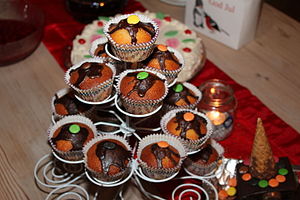| Revision as of 16:35, 26 May 2005 view sourceMothperson (talk | contribs)2,231 edits starting expansion - temp save← Previous edit | Revision as of 19:43, 26 May 2005 view source Mothperson (talk | contribs)2,231 edits adding - temp saveNext edit → | ||
| Line 7: | Line 7: | ||
| The British version, celebrated in the nursery rhyme about the ], is predecessor to what is known in ] as the ]. It is a thick, flat bun, typically about eight centimetres in diameter. This muffin is usually split into two, ]ed and ]ed, and bears resemblance to the ] or ]. | The British version, celebrated in the nursery rhyme about the ], is predecessor to what is known in ] as the ]. It is a thick, flat bun, typically about eight centimetres in diameter. This muffin is usually split into two, ]ed and ]ed, and bears resemblance to the ] or ]. | ||
| American muffins may have started out as a form of small ], or possibly an adaptation of ]. Early versions of these muffins tend to be less sweet and much less varied in ingredients than their contemporary forms. Made quickly and easily, they were useful as a breakfast food. They also rapidly grew stale, which prevented them from being a marketable baked good, and they were not seen much outside home kitchens until the mid-20th century. |
American muffins may have started out as a form of small ], or possibly an adaptation of ]. Early versions of these muffins tend to be less sweet and much less varied in ingredients than their contemporary forms. Made quickly and easily, they were useful as a breakfast food. They also rapidly grew stale, which prevented them from being a marketable baked good, and they were not seen much outside home kitchens until the mid-20th century. Recipes tended to be limited to different ]s – ], ], ] – and a few readily available additives – ], ] in some form, or ]. | ||
| In the 1950s, packaged muffin ] were introduced by several American companies. By the 1960s, attempts were being made to treat the muffin like the ] as a ] business opportunity. Coffee-shop style ] appeared, featuring a a wide variety of muffins. These tended to be regional, such as "The Pewter Pot" in southern ]. No such business has emerged nationally in the U.S. (although doughnut chains have edged into the business), but ]'s "Muffin Break" has spread to ] and the ], featuring the American-style muffin. | |||
Revision as of 19:43, 26 May 2005

The word muffin is given to two types of breadstuffs, one a yeast-leavened item, and the other a "quick" bread raised with baking powder or baking soda.
The yeast-raised muffin is the oldest version, appearing in Britain as a word derived from the French moufflet, around the 11th century A.D. The other type is an American development from the 19th century.
The British version, celebrated in the nursery rhyme about the muffin man, is predecessor to what is known in American English as the English muffin. It is a thick, flat bun, typically about eight centimetres in diameter. This muffin is usually split into two, toasted and buttered, and bears resemblance to the crumpet or pikelet.
American muffins may have started out as a form of small tea cake, or possibly an adaptation of cornbread. Early versions of these muffins tend to be less sweet and much less varied in ingredients than their contemporary forms. Made quickly and easily, they were useful as a breakfast food. They also rapidly grew stale, which prevented them from being a marketable baked good, and they were not seen much outside home kitchens until the mid-20th century. Recipes tended to be limited to different grains – corn, wheat bran, oatmeal – and a few readily available additives – raisins, apples in some form, or nuts.
In the 1950s, packaged muffin mixes were introduced by several American companies. By the 1960s, attempts were being made to treat the muffin like the doughnut as a franchise food business opportunity. Coffee-shop style restaurant chains appeared, featuring a a wide variety of muffins. These tended to be regional, such as "The Pewter Pot" in southern New England. No such business has emerged nationally in the U.S. (although doughnut chains have edged into the business), but Australia's "Muffin Break" has spread to New Zealand and the U.K., featuring the American-style muffin.
Orange Choc-Chip Muffins
| This page is a candidate for copying over to the Wikibooks Cookbook using the Import process. If the page can be edited into an encyclopedic article, rather than simply a recipe, please do so and remove this message. To facilitate the copying of this article, please consider listing it on Wikibooks:Requests for Import. Check to see if the cookbook already has a page about this recipe or ingredient and alternatively use a soft redirect if appropriate. |
- 400g self-raising flour
- 60g butter
- 120g sugar
- 12cL cup milk choc. bits
- 12cL cup white choc. bits
- 2 eggs, beaten lightly
- 12cL cup milk
- 12cL cup orange juice
- 15mL orange rind
Preheat oven to 220ºC. Sift flour onto bowl, rub in butter. Add sugar, milk choc. bits and white choc. bits, eggs, milk, orange juice and orange rind. Mix well. Spoon heaped tablespoons of mixture into greased muffin pans. Bake for 15-20 minutes until cooked when tasted. Makes 12.
See also
State Muffins
Several states of the United States have a state muffin:
- Minnesota- blueberry muffin
- Massachusetts- corn muffin
- New York- apple muffin